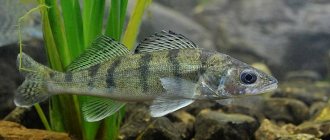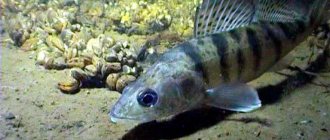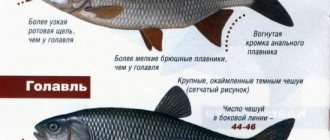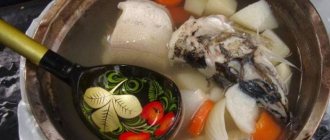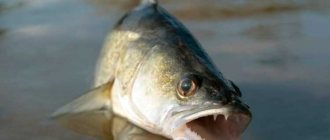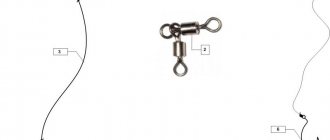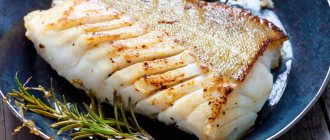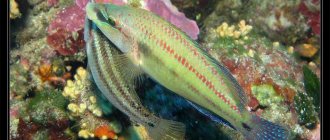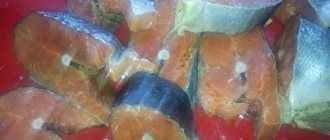Bersch (lat. Stizostedion volgensis), like all representatives of the Perch family, is carnivorous and gathers in schools. Otherwise, it is also called Volga pike perch. Fishermen really like bersh: it is beautiful, its meat is quite tasty, suitable for frying, boiling and fish soup. This fish is not caught for industrial purposes, and fishermen rarely hunt for it purposefully, but it is considered a valuable trophy. Before you start catching false pike perch, make sure that it is not prohibited in your region - after all, bersh is a species included in the Red Book.
Description of the fish
In appearance, the bersh immediately resembles both pike perch and perch. It has a long body, densely covered with small scales. It stands out for its large eyes and the presence of a small hump. There are dark stripes on the body of the fish. The fins are quite large, the two front ones consist of bony spines connected by a membrane.
The fish is found only in Russia. Loves clean bodies of water with moderate currents and a bottom made of pebbles, sand or stones. It is found in small quantities in rivers that flow into the Azov, Caspian and Black Seas, and in reservoirs such as Tsimlyanskoye, Kuibyshevskoye and Volgogradskoye. The predator is most common on the Volga. They usually live in rivers for no more than 6 years.
This fish is usually found in fresh water, but is also found in the sea, although it never goes out into the open sea.
Individuals reach sexual maturity in the 4th year of their life. Spawns in spring, when the water warms up to +10°C. Females choose places up to 2 m deep and lay small yellow eggs in nests. The eggs are less than 1 mm in size. Their number is approximately 300,000. The males then guard the eggs from predators. After 5 days the larvae appear. At first, the larvae feed on the remains of the gall sac, then they move on to plankton and algae.
Bersh and pike perch
Externally, bersh is very similar to pike perch. They belong to the same family and are often found together. Even experienced fishermen can easily confuse them. Some are even sure that these are the same fish.
Externally, bersh is very similar to pike perch
Features
Fish differ in their weight. Bersch rarely reaches a weight of 1.2 kg. More often you come across fish about 30 cm long and weighing 400 g. During the first year of life, the Volga pike perch reaches a size of about 8 cm.
The depth that the fish prefers may also differ. Pike perch usually stays at 10 m. An adult bersh goes at least 14 m. Juveniles wash ashore, but also live near the bottom. It happens that small bershik is found in a school of pike perch.
Unlike pike perch, bersh's teeth are small and there are no sharp fangs.
The color of pike perch is less bright. The black stripes of the bersh stand out more clearly. The back has a greenish tint, and the sides and belly are gray. On the gill covers you can see small scales that are whiter than on the body. The head is shorter and wider than that of pike perch, and has a blunt shape. The scales are larger. The fins touch on the back. The lateral line is shorter. The eyes are slightly larger.
The younger brother of pike perch is bersh
Today we offer the topic: “pike perch’s younger brother - bersh” from professional fishermen. We tried to cover the topic as fully as possible. You can ask all questions in the comments after the article.
Catching bersh will leave an indelible mark on your memory. Rich impressions and excitement are guaranteed. Since bersh is a schooling fish, catching a large catch in a day will not be difficult even for novice fishermen. To catch a predator you do not need to have any special devices. Bersh is often used in cooking; its divine taste will not leave anyone indifferent. Bersha fillet is considered softer and tastier than pike perch fillet.
Bersh is a fish from the genus of pike perch, which belongs to the perch family. Commonly called “Volga pike perch”. Bersh differs from pike perch primarily in size, which is about 35 - 45 centimeters. The average weight of a predator is 700 grams - 2.5 kilograms. It is very easy to confuse pike perch and pike perch. To understand the difference between pike perch and pike perch, let’s look at the distinctive characteristics:
- The bersh does not have lower fangs, unlike the pike perch.
- There are even large scales on the cheeks of the fish.
- The bersha has about 70 rows of scales (the pike perch, similar to the bersha, has about 90 rows of scales)
- The stripes on the body of the fish are more distinct.
- Pike perch can be found in lakes, but its predator brother is found only in rivers.
- A significant difference between the bersh and the pike perch is the head of the bersh, it is shorter and wider.
- Bersh may also differ in that it can only be found in rivers of the Black or Caspian Seas.
When the fish reaches 20 centimeters in size, around the fifth year of life, puberty occurs. The best place for spawning is not a deep sandy bottom, about two meters. These conditions are suitable for fish to create a cozy place where they feel safe. After the female lays eggs, she swims away from the “nest”, and the male, in turn, remains to watch and protect the eggs from other fish. Most often, spawning occurs at the end of April or beginning of May. Provided that by this time the water has warmed up to at least 8 - 11 degrees Celsius. The incubation period is about five days. A week after the appearance of the larvae, the fry reach five centimeters. The fry feed independently on algae and plankton.
Photo 1. Bersha has brighter stripes on its side.
Bersh fish prefer to feed, like pike perch, most often these are minnow fry. Due to the fact that it does not have lower fangs, it cannot capture larger fish, so the main food of the predator is fish fry, the size of which is about 4 - 5 centimeters. The fish feeds intensively in spring and autumn, but in summer, on the contrary, its appetite decreases significantly.
- Spinning . Fishing will be more successful from mid-June to the end of August. Fishing with a spinning rod is recommended in places where the bait cannot catch on the grass. It is better to use spinners, mostly light colors, standard load. There is no need to use a leash; the fish most likely will not be able to bite the line. The attack of the underwater inhabitant occurs very slowly, so do not forget to pause in your movements. You can also muddy the waters. While gently tugging the artificial bait, slowly lower it to the bottom of the pond. For this type of lure, use a single hook. It is better to fish in the evening or at night, because the predators are twilight fish. If you are fishing from a boat, make sure that the boat is stable enough, as the berche fish can resist strongly.
Photo 2. Bersh readily bites on silicone bait.
- Float rod. When fishing with a float, pay special attention to the bait. If the fish is already dead, be sure to burst its swimming bag, otherwise your bait will constantly float up. You can fish with a float rod, but the weight of the fish will not be more than 1.5 kilograms. Even with such a small weight, you should look for a fishing rod that is strong enough. The fishing line should be of high quality, with a diameter of 0.15 - 0.18 mm. Bersch is a stubborn predator that has no problem damaging fishing gear. For a natural action of your bait, use a treble hook.
- Mugs . Catching a predator with circles is similar in principle to catching a pike. If you manage to spot a school of fish, try to point the mugs exactly at the center of the fish cluster, otherwise the fish simply will not notice the tackle. You need to install tee hooks on the mugs, and you also need to stock up on more than enough fishing line, this will help the fish not feel resistance. Let the circles be approximately 60-65 centimeters from the bottom. Those who are just starting to fish with mugs should not be upset if they fail, as it will not work out right away; with more experience, everything will definitely work out.
- Bottom tackle. A popular type of hunting for pike perch is fishing for donka. They install it late in the evening and check their catch in the morning. This method is practically fail-safe; even beginners will not have any difficulty catching bersh this way. Also, for donk fishing, you can use various alarms that will notify you of a bite. Don't forget to take care of the bait, which is easy to make with your own hands.
- A fishing rod for vertical trolling. Suitable for both pike perch and bersh fishing. Only a smaller bait should be used; for fish weighing about 500 grams, use a bait no larger than three centimeters. The spoon is set about 35 centimeters from the bottom, and they begin to lower and raise it smoothly.
- Nodding fishing rod. Bersh and pike perch are caught on a nod fishing rod in the same way, but as practice shows, there are significantly more bites for bersh than for pike perch. In the form of bait, you should give preference to small baits, worms or larvae. The nod is an integral part of the fishing rod, it is important that it is elastic, this will help to better control the bait, and is also frost-resistant, since winter can be quite harsh.
- Fishing with sprat. This method is the easiest to use. You can use both frozen and fresh sprat. The predator focuses specifically on the fishy smell, which means that the chances of catching a large catch increase. You should not use too large a sprat as bait; the fish may simply bite off part of the bait and swim away.
In winter, the predator lives at the bottom. Catching bersh in winter is successful with the help of jigs and spinners. The bait is chosen at the discretion and experience of the fisherman. Much depends on the mood of the fish and the nature of the weather. One day the fish will bite only on a jig or, conversely, as much as on a spinner. You need to try and experiment. In winter, you can choose absolutely any spinners with fairly bright or reflective colors. Choose a lighter spoon, otherwise bites will be unsuccessful and rare. If you use a bait in the form of a jig with a light weight, the fish will hook it and swallow it itself. With this method of fishing, do not forget to use a leash attached to the fishing line 30-40 centimeters above the jig. This will help make the hook less sensitive to the fish. Select leash sizes depending on the nature of the current. If the current is quite weak, a leash measuring from 7 to 10 centimeters is suitable, and if the current is strong, use leashes up to one meter in size.
Leashes do not need to be used if the predator bites well on the main bait; using a jig in this case is not advisable; it is better to use a simple sinker.
Photo 3. In winter, bersh are caught more often than their older brother, pike perch.
The ideal bait in the summer will be the usual food of the underwater inhabitant - fish fry. Due to the small size of the fish's mouth, use live bait as small as possible. Approximately five to seven centimeters.
If you are fishing with a float, use worms or maggots according to the size of the hook you are using. Otherwise, the fish will notice the hook, and the worm will quickly die on the large hook. For luring, narrow oblong lures of light colors are suitable; spinners and spoons are also popular among bershas.
When you find a school of predators, you are guaranteed a good catch, the main thing is to use the right bait. The winter and summer catch of bersha will not leave anyone indifferent. If you are still looking for bersh, go to the tributaries of the Volga River with the right equipment and bait, and dinner in the form of baked bersh on your table is guaranteed.
Bersh fish. The long December nights captured most of the day in cold captivity, leaving only a short period of time for the sun. It seems that all nature has plunged into a harsh New Year's sleep. Frosty winter mornings shrouded the deep-sea backwaters on the Volga-Mother with an ice shell, thereby giving the go-ahead for ice fishing.
The local fishing class will not miss their chance and, at the first opportunity, will clear all promising holes from pike perch. And poachers won’t let the poor “thorns” escape; there are fixed nets every 100-200 m; large pike perch cannot escape from them. There is only one consolation left, the younger brother of pike perch - bersh.
Fishing Features
You can use different fishing gear:
- spinning rods;
- donks;
- girders;
- float rods.
Wobblers and jig heads are effective. Sometimes shiny drop-shaped jigs are used. Most often they use spinning fishing from a boat or shore.
If the choice fell on a float rod, then make sure that the tackle is strong. Keep your bait near the bottom.
Bersha is actively caught with lures, using narrow double-sided perch spoons of light colors. Spoons are moved in two ways. The first is that the spoon is alternately raised and then lowered to the bottom. The second method is attractive because the raised spoon is lowered into the water to the end, and then pulled along the bottom. If there is no spoon, then a jig head will do instead.
In weak currents, use a large jig with a large hook. To do this, take a fishing line with a diameter of 0.2 mm and a light weight. Bersh is frightened by sharp jerks, so perform smooth movements with small twitches of the tackle.
Since this fish lives in schools, it is good to use an echo sounder to detect its concentrations.
It is more difficult to catch fish in winter because they are not looking for food. Then you should use fishing rods with an inertial reel and fish in deep places and under snags. Sometimes a pike rig helps. Installation occurs as follows: the sinker is lowered to the bottom, which helps the baitfish stay quite deep, thereby attracting prey.
Fish winter in deep places. To find its parking place, you need to actively move and drill many holes. However, you can choose a specific place and wait there. Any of these tactics has a right to exist.
In nature, adults prefer to feed on young fish and crustaceans. Juveniles love plankton and insect larvae. The size of the bait or part of it should be 2-5 cm. Due to the anatomical structure of the mouth, the predator cannot feed on large fish. Only the largest individuals can swallow fish 8-10 cm. You can use a frog. But it is not necessary to take live bait for fishing.
Fishermen use worms and bloodworms in winter. The bloodworm is planted in a bunch. Pieces of lard and various larvae are also suitable.
Usually on the Volga bersha is caught in autumn, winter or early spring. It bites most actively from dawn to 12 noon. During the day, the bite stops, and with the onset of dusk, the activity of the fish increases. In the winter season, you should not fish at night. It is better to start winter fishing when there is strong ice.
Unlike pike perch, bersh's teeth are small and there are no sharp fangs.
Methods of catching bersh
Fishermen do not specifically catch this fish , but for fishing enthusiasts it is a desirable prey.
- In summer, this predator is almost never caught; it is hunted in winter, autumn or early spring.
- They are caught in the current from ice or from a boat.
- The diameter of the fishing line should be no more than 0.2 mm. A thin line will get tangled, and a thick line will float in the current.
- It is better to use large elongated jigs for fishing.
- Sprat or verkhovka is used as a bait.
Tackle for catching bersh
Float rod.
This tackle catches bersh, whose weight is up to 2 kg. The predator is a fairly lively fish, so the fishing rod must be strong. Otherwise, he can easily damage it. Fishing lines should be used so that the fish can be pulled out without a hook or landing net.
Spinning.
This bersha fishing device should be used to fish in places where you can move the lure without snagging.
- The spoon should be light, oscillating and well weighted.
- The predator does not bite the fishing line, so there is no need to use a metal leash.
- Due to the fact that fish often set up ambushes, it is best to make a stepwise retrieve or not move the lure very quickly at the very bottom.
- Bersh grabs the bait slowly, so pauses should be made at the extreme points of the retrieve.
The boat from which a predator will be caught using a spinning rod must be stable. A rubber bedpan will be difficult to hold and not very comfortable to stand on.
"Donka".
This gear is the most common among fishing enthusiasts. Fishing is almost always successful if you leave the “donk” overnight and check its contents in the morning.
“Donka” with a sliding sinker can also be fished from a boat. The main thing is that the line passes through the sinker freely. Another condition when using this gear is that the fish, when swallowing live bait, should not feel its resistance ahead of time.
Mugs.
With their help, bershas are caught in the same way as pike.
- Mugs should be sent to known places where predators gather.
- Sometimes gear passing a few meters from the fish may not be noticed by it.
- If fish have accumulated on the slope of an underwater channel, then the circles should swim along it. In this case, the likelihood of a bite increases.
The fish bite especially briskly in the morning, until twelve o'clock in the afternoon, then there is a break in the bite for two or three hours. But at this time a small pike perch is vigorously biting.
Despite the fact that bersh is a small fish, it can be caught with any gear, and the gastronomic qualities of this predator are better than those of pike perch.
Common pike perch
The differences between pike perch and bass are important for any angler. Only by thoroughly studying the habits of two predators can you successfully catch one or another fish. There is much more information about pike perch.
On the Don and the coast of the Azov Sea, people call it sula. Knowing the habits of pike perch, you can choose the right feeding, tackle, bait and place for fishing. The result is a rich catch and a good mood.
The range of the common pike perch is quite wide. It can be caught in rivers flowing into seas and lakes such as:
- Baltic.
- Caspian.
- Azovskoe.
- Aral.
- Black.
- Issyk-Kul.
- Balkhash.
- other bodies of water.
This fish is quite large. There is evidence of catches of individuals more than a meter long and weighing 15 kg. It is quite possible that even larger specimens exist.
A characteristic feature of this fish is the presence of fang-shaped teeth, giving it a ferocious appearance. Females look more modest, their fangs are shorter than those of males.
Appearance
There are several varieties of this fish, differing in the color of their scales and the shape of their fins. All of them have an elongated fusiform body, laterally compressed. The scales are small, with uneven jagged edges and sit firmly in the skin. The scaly cover covers part of the head and tail. The lateral line extends onto the caudal fin. There are two fins on the back, they are either separated by a short distance or touch each other.
In one dorsal fin, which is closer to the head, all the rays are hard and spiny. In another - only 1-3, the rest are soft. The same “spines” are present in the anal fin and two ventral fins. The membranes of the fins on the back and tail are dotted with small spots of dark color.
The jaws are elongated, the teeth are sharp and small. The mouth is large and has fangs. There are hard spines on the gill bones.
The back is greenish-gray, darker closer to the fins. The belly is white or gray. Transverse stripes are clearly visible on the sides. They are brown-black, up to 10 or more pieces.
Lifestyle
Pike perch is a predator. The diet mainly consists of small fish. The fry do not disdain invertebrates, eating them in unlimited quantities.
It is practically not found in swampy and muddy waters, as it is very sensitive to a lack of oxygen.
In summer, in hot weather, it stays at a depth of 2-5 meters. Active both day and night. Reflectors located behind the retina of the eyes help in night hunting - so that there is enough moonlight to see clearly.
Night hunting takes place in shallow water or at the very surface of the water, and characteristic splashes can be observed. During the day it goes deeper.
Prefers a sandy and pebble bottom with large driftwood, debris and stones. He ambushes them and then rushes to prey.
It spawns in the spring, when the water temperature is above 12 degrees, usually in April-May. It lays its eggs in shallow water, in places where there is a lot of driftwood and other debris. The caviar is yellowish in color, small. It begins to spawn upon reaching the age of 3-4 years.
Pike perch is highly valued as a commercial fish , so its catch is limited in some countries.
How to distinguish bersh from ordinary pike perch
To see the most important difference between berche fish and pike perch (common and sea), you need to look into its open mouth and examine the teeth on the jaws and palatine bones. We will make sure that the Volga pike perch (or bersh) does not have fangs (the other two species have them).
Other distinctive features:
- The cheeks (gill covers) are completely covered with scales (in pike perch the covers are bare).
- The mouth is shorter - the upper jaw does not extend beyond the vertical edge of the eye, but only reaches the vertical line passing through the middle of the eye.
- The forehead (distance between the eyes) is very narrow; this gap is smaller than the diameter of the eye.
- The shape of the head is slightly higher and slightly shorter in comparison with the common pike perch.
- Both fins on the back always touch, and the first of them is shorter than the second.
In the photo of the bersh fish, you can see many of the above-described signs.
The difference between bersh fish and pike perch is also manifested in the maximum size: bersh cannot be more than 45 centimeters in length and more than one and a half kilograms in weight.
Photos of bersh fish and common pike perch, placed side by side, make it possible to verify that these species can be easily distinguished by the features of their external structure, which were described above.
Distribution and lifestyle
Volga pike perch (bersh) is an exclusively freshwater fish that inhabits the rivers of the Caspian and Black Sea basins. It rises very high along the Volga and Ural rivers. And when introduced into reservoirs, it can reach large numbers in a short time, and at the same time grows well. Successfully completed acclimatization in Lake Balkhash and the Kuban River. Found in all rivers of the Kuban basin.
Lifestyle
Bersh fish, also called Volga pike perch, is an exclusively freshwater inhabitant that never leaves rivers for the sea. The fish is characterized by a bottom-dwelling lifestyle. Where bersh accumulate in rivers depends on the season.
In the summer months, fish concentrate in that part of the reservoir where the maximum amount of food is located:
- Juveniles accumulate near the shore in shallow water.
- Adults are numerous in the deep-water parts of the reservoir (river beds and the central part of the reservoir or lake).
During the winter months, all fish move to deep places in reservoirs, where they spend the winter near the bottom. In some reservoirs, for example on the Volga, Volga pike perch can be found at different depths with different soils and current intensity:
- In shallow water in places with rocky and sandy soil in the presence of a slow current.
- At depths with a muddy bottom up to 40 meters.
The bersh is most active in the evening and morning. During the day, fish are inactive. Sometimes they can make short migrations. Such phenomena were noted for the Volga delta and some reservoirs (Samara and Kuibyshev).
Nutrition and growth
Bersh fish is characterized by a mixed type of nutrition:
- Fry up to 25 millimeters in size feed on small plankton, for example, daphnia, diaptomus, and cyclops.
- Juveniles measuring 25–40 millimeters in size begin to eat dragonfly larvae, as well as chironomid pupae crawling along the bottom.
Larger individuals (more than 40 millimeters) have a more varied diet, consisting of nektobenthic crustaceans (gammarus and mysids); crayfish, as well as small fish (goby sandpiper, spiny goby, juveniles of various perches, gudgeon), the length of which is no more than ten centimeters.
Growth rate
Compared to ordinary pike perch, bersh grows more slowly. But in different conditions the rate of its growth is different. Research by fish breeding scientists has shown that in one area, the most intense growth is observed in a reservoir than in a river. For example, the length of a one-year-old bersh in the Don River is 77 millimeters, and in the Tsimlyansk Reservoir - 90 millimeters.
Reproduction
Bersch becomes sexually mature and begins to reproduce in the third or fourth year of life. Its length at this time is in the range: twenty - thirty centimeters. Spawning grounds are usually located in shallow water with sandy soil (on sand spits). Here, at a depth of about two meters, eggs are deposited on the rhizomes of aquatic plants. The clutch is guarded by the male. Spawning often occurs near pike perch nests.
Spawning occurs in mid-spring (April-May), as soon as the water reaches 10 degrees. Spawning is portioned and extended: eggs are laid in two portions over the course of one month. Bersha caviar is quite small: the diameter of the egg is from half a millimeter to 0.8 millimeters. In the first portion the caviar is slightly larger than in the second.
Yellow eggs are spawned in huge quantities - from 44 thousand to almost 500 thousand pieces (depending on the reservoir).
Egg development lasts approximately four to five days. The size of the hatched larvae is about half a centimeter. After resorption of the yolk sac (at one week of age and a little more than half a centimeter in length), the fry begin to independently obtain food: a variety of small zooplankton and diatoms.
Species status
Bersh is a commercial species. But over the past decades, the volume of its production has decreased significantly due to the unfavorable environmental situation in reservoirs, namely due to water pollution. The second reason is associated with fluctuations in water levels in the spring during flow regulation (in reservoirs): such measures cause the drainage of spawning grounds, and as a result, the death of eggs and larvae.
In 2001, the bersha population living in the Ural River basin was included in the Red Book of the Russian Federation. It has been assigned status 3, which means a rare population. There is no information about its number. In the waters of the Russian part of the Urals, bersh has always been rare, and this was done to preserve the species.
Bersh or Volga pike perch
A small fish, similar in appearance to pike perch, up to 45 cm long. The average weight of an adult is 1.2-1.4 kg.
It is believed that bersh is a purely Russian fish . This is due to the fact that it is found only in Russia and the CIS, in the rivers of the Caspian and Black Seas. There is no other reliable evidence.
There is very little information about this predator. They are mainly drawn from the stories of fishermen who encounter bersha in one place or another. Due to its similarity with pike perch, it is often mistaken for juveniles of this fish, although there are quite a few differences.
Distinctive features
Despite its external resemblance to pike perch, this fish is closer to perch. At one time it was even believed that it was a cross between two fish. How does bersh differ from pike perch:
- shorter and wider snout;
- large eye size;
- teeth of the same size, without fangs;
- scaly cheeks;
- larger scales and smaller rows of them;
- fewer transverse stripes - 8 of them;
- more regular and clear stripes.
All these differences are clearly visible.
This fish is not found in large quantities anywhere. Most often it is caught in the Volga, but only in some places. This is mainly the section of the river below Rybinsk - the bersh does not rise higher upstream.
There is information that it is caught in Belozerye, in the Ural and Sheksna rivers, in the Caspian and Baltic bays. They are quite confusing and contradictory. Nobody knows the exact habitats. This fish has generally been little studied, perhaps due to its similarity to pike perch.
Found in deep places with sandy or rocky muddy bottoms and currents. It was not found in lakes with stagnant water. And just like pike perch, it prefers water saturated with oxygen.
The diet is similar to the diet of pike perch - small fish and invertebrates. It has all the habits of a predatory fish. Keeps in packs.
It spawns later than pike perch, at the same time as bream. The fry swim near the shore, where it is easier to find food.
Catching bersh
In the lower reaches of rivers it bites in spring and autumn. According to fishermen, it’s better in the fall. Bersch, as already noted, lives in flocks and is especially active in the early morning and evening.
Main differences
They are really similar to each other because they live in identical conditions. This also applies to nutrition. Some argue that the bersh appeared as a result of the union of pike perch and perch: they say that it took its color from the first, and the small size and shape of the body from the second parent. In fact, the bersh is a separate species of predatory fish from the perch family.
The appearance of both representatives of the ichthyofauna is really similar, their habits and lifestyle also have similar features, but there are differences between bersh and pike perch, and there are quite a lot of them. If small individuals can still be confused, then with age the difference becomes obvious. The first thing that cannot be ignored is the absence of fangs in the bersh. Pike perch have them from birth. If you carefully examine adult individuals, you will notice that the stripes on the body of the bersh are clearly expressed, while in pike perch they do not have clearly defined boundaries.
The size of the fish is another parameter by which the difference can be determined. Bersh cannot boast of significant values: the weight of an adult does not even reach 2 kg. But the weight of pike perch can easily exceed 10 kg.
Description
Bersha cannot be classified as a large freshwater predator, since its maximum weight rarely exceeds 2 kg. The length of the predator can reach 50 cm. The prey of amateur fishermen is usually individuals weighing no more than 1 kg. Like other representatives of the perch family, bersh leads a gregarious lifestyle. Only the largest individuals can be found alone.
This fish is characterized by a rather bright color, in which dark transverse stripes are especially prominent. The sides of the predator are golden in color with a grayish tint. Green tones predominate in the upper part of the body. The belly is white. The cycloid scales of the bersh have a rather dense structure and reliably protect it from various external influences. The cycloid scales that cover not only its body, but also the gill covers, are much larger than those of perch and pike perch. All the bersh's fins are well developed, which makes it a typical predator capable of actively pursuing its prey.
An external description of the bersh would be incomplete without mentioning its large, bulging eyes. Large visual organs have increased light sensitivity, which allows the predator to hunt at considerable depths, where illumination is at a very low level. The bersh's mouth is studded with many small teeth that can reliably hold caught prey.
Area
Unlike pike perch and pike perch, the population of bersha is very small. This fish cannot be found in Siberia and the northern regions of the country. The largest population of this predator is found in the waters of rivers flowing into the Caspian Sea. In the rivers of the Astrakhan region, bersh is the main food competitor of pike perch and is often caught by fishermen. This predator will never be found in shallow ponds and lakes with poor oxygen conditions.
It is found in small quantities in the Dnieper and other rivers of the Black Sea basin. Bersh usually inhabits the lower and middle sections of rivers. It rises to the upper reaches extremely rarely. In recent years, the number of this predator has increased in reservoirs in the southern regions:
The good food supply of these reservoirs contributes to the rapid growth of bersh. In the Tsimlyansk Reservoir you often come across trophy specimens whose weight exceeds the two-kilogram mark.
In reservoirs it prefers to occupy deep places, not far from holes and channel edges. Often found near schools of pike perch, but tries to stay away from its larger brother.
Nutrition
The feeding pattern of the bersha directly depends on the age of the individual. The first months after hatching from the egg, the fry feeds on small aquatic organisms:
After 4–6 months, the grown fish begin to hunt juvenile carp fish species. At this age, the predator gathers in large flocks and, in search of food, goes to shallow areas of the reservoir, where the depth does not exceed 50 cm. Such outings can often be observed in the morning and evening hours.
The main part of the diet of adult individuals consists of small fish of carp breeds, distinguished by their slender body shape:
The mouth of the bersh is not as large as that of the pike, so the size of its prey usually does not exceed 10 cm. The greatest activity of this predator is observed in the first autumn months, when the water begins to cool quickly. In the autumn, it can be successfully caught throughout the day. In summer, it is better caught at morning and evening dawns. In July, when the water temperature can exceed 25 degrees, the bersh switches to feeding at night. In winter, it loses its activity a little, but continues to feed throughout the entire freeze-up period.
Spawning
The bersh becomes sexually mature in the fourth year after hatching from the eggs. By this time, it has a body length of about 20 cm and a weight of 150–200 g. The spawning grounds are shallow areas of the reservoir with a sandy bottom and a complete absence of current. The female lays eggs not on clean soil, but on a variety of underwater objects:
- tree rhizomes;
- aquatic vegetation;
- underwater rocks.
After spawning, the male remains at the spawning site and continues to guard the eggs laid by the female. It stays in shallow water until the fry hatch, and then goes deeper and begins to actively feed.
In the southern regions, the spawning period occurs at the beginning of April. In the middle zone, bersh spawn in late May - early June, when the water temperature rises above 15 degrees. If river individuals spawn 200–250 thousand eggs, then fish living in the Tsimlyansky and Kuibyshev reservoirs are 2 times more fertile. The first fry begin to hatch from the eggs after 5 days. For the first week, they feed from the yolk sac, which envelops the contents of the eggs. After 7–10 days, the fry switch to feeding on small invertebrates.
Differences from zander
Bersch and pike perch are very similar to each other not only in appearance, but also in a number of other characteristics. These species often coexist on a pond and are caught on the same type of bait. Many anglers often confuse these fish and mistakenly believe that they are not catching a mature bersh, but a small pike perch. You can distinguish bersh from pike perch by several characteristics:
- pike perch have fangs that are clearly visible upon visual inspection;
- the outer side of the gill covers of the bersh is covered with scales, while the gills of the pike perch are devoid of scaly cover;
- The transverse stripes of the bersh are most pronounced.
What is the difference between bersh and pike perch?
In some, mainly southern reservoirs of Russia, two similar predators of the perch family live - bersh and pike perch. Although the bersh is called the Volga pike perch, it does not belong to the ordinary pike perch. At a quick glance, the fish are very similar, but there are several significant differences between them.
How to distinguish pike perch from bersh
The difference between pike perch and bershak is not only in appearance. Fish also have different habitats and spawning periods. There are also peculiarities in catching “relatives”.
Spawning
These two species also differ in terms of spawning:
- pike perch spawns from early April to mid-May at water temperatures above +10 0C;
- Bersha spawning occurs a little later, from mid-April to mid-May.
Their spawning places are the same - areas with weak currents, clay or pebble bottom. At the same time, the Volga pike perch has an undeveloped parental instinct: after spawning, the male does not guard the clutch of eggs.
Fishing Features
The differences in fishing methods for these two species are not as significant as in appearance, habitat and timing of spawning:
- Common pike perch is caught in holes and pools using spinning rods and mugs. For spinning fishing for fanged lures, artificial baits such as heavy oscillating spoons, twisters, vibrating tails made of edible silicone, and diving minnow-class wobblers are used. For mug fishing, juveniles of narrow-bodied fish species - bleak, perch, roach, gudgeon, dace - are used as live bait.
- In bersh fishing, in addition to spinning rods, circles and girders, they often use a live bait float rod and bottom tackle. Small bershik can also be caught on a regular fishing rod with a large dung worm.
In winter, both species can be caught well with vertical spoons, balance beams and girders.
Finally
Belonging to the same family, predators differ in appearance, habitat, timing and duration of spawning, and the gear used to catch them. Being able to distinguish them is useful not only for general erudition. For example, in the Ural River basin, bersh is a protected species listed in the Red Book of Russia.
What is the difference between bersh and pike perch Link to main publication
Source: https://ribolovrus.ru/ryby/chem-otlichaetsya-bersh-ot-sudaka
Catching
Fishing for bersh can be very interesting both in open water and from ice. In open water, this predator is usually caught using a spinning rod. The most exciting and challenging fishing is using spinning tackle. If we are talking about fishing on a deep river with a moderate current, then the fisherman will need quite powerful gear that allows long-distance casting of heavy bait. Such gear consists of several elements:
- spinning rod 2.4–2.7 m long with a test range of 30–80 g;
- spinning reel series 3000–3500;
- braided cord with a diameter of 0.10–0.12 mm;
- guitar string leash.
Since fishing is predominantly carried out using the jig method, which requires increased sensitivity of the gear, the spinning rod must have a fast or ultra-fast action, ensuring the registration of every touch of the fish to the bait. In addition, the combination of a rigid rod and a braided cord will not only allow you to feel the bites of a predator well, but will also make it possible to determine the nature of the structure of the bottom relief.
If the angler fishes from a boat, then particularly long casts are not required. For fishing from a watercraft, a spinning rod with a length of 2.4 m is sufficient. A longer rod is useful when it comes to coastal fishing and the fisherman needs to cast over a long distance. Since fairly heavy baits are used for fishing on a deep-sea river, the upper limit of the test range of the rod should not be less than 80 g.
A “braid” with a thickness of 0.10–0.12 cm is wound onto an inertia-free reel. The braided cord has an elongation coefficient close to zero and makes the tackle more sensitive. In addition, a thin cord is less susceptible to drift, which also increases the information content of the gear.
Bersh is not able to bite through a braided line, but when bottom fishing you must use a metal leash. This is due to the fact that the part of the “braid” closest to the bait constantly rubs against the bottom soil and wears out quickly. A metal leash will help prevent the cord from fraying and increase the reliability of the gear. The experience of many spinning anglers proves that the presence of a metal leash in the equipment does not have a negative effect on the bite of the bersh.
Since the bersh's mouth is relatively small, medium-sized baits 6–9 cm long are better suited for catching it. To catch this predator, it is better to use:
- vibrotails;
- twisters;
- small jigs;
- composite baits made of polyurethane foam.
The color of silicone baits is selected taking into account the characteristics of the reservoir and the activity of the predator. If dark and natural colors show good results in clear water, then yellow and carrot colors will work better in cloudy water.
For fishing in the reservoir, you can use more delicate gear, which is due to the lack of current and the use of bait weighing no more than 40 grams. The type and size of baits for fishing in still water are no different from those used for fishing on the river. The main difference is the weight of the jig head mounted on the bait.
During the period of open water, you should look for bersha at a depth of 7–12 m. During the daytime, this predator bites in places with sharp changes in depth. In the morning and evening hours, bersh can be caught on flat plateaus, which are located not far from the main channel or a deep hole, where it goes out to hunt for fry.
Bersha can be successfully caught from ice in winter. For river fishing, gear consisting of the following elements is most often used:
- winter fishing rod with an elastic nod;
- fishing line about 0.22 mm thick;
- cargo weighing 30–50 g;
- leash with hook.
This tackle is easy to manufacture, so even a novice angler can easily assemble it. About 20 m of fishing line with a diameter of 0.20–0.24 mm is wound on a winter fishing rod. A sinker weighing about 40 grams is tied to the end of the main monofilament. A small loop is formed 30 cm above the tied load, to which the leash will subsequently be attached. The length of the leash should be at least 80 cm, which will ensure the nozzle actively plays in the water flow. A single hook No. 4–3 is attached to the leash.
An angler usually uses several of these fishing rods at once, placing them at some distance from each other. The fish bite is clearly visible by the sharp bending of the guard. It is better to attach frozen sprat to the hook of such equipment, which the bersch really likes and is its usual food.
At the reservoir, bersh are caught using spoons and balance beams 6–8 cm long. To catch it, use a fishing rod equipped with a reel and a hard whip, which allows you to clearly cut through the bony mouth of the predator. Bersh bites on artificial winter baits can be very aggressive and are well transmitted to the hand, so the fishing rod does not need to be equipped with a nod.
In winter, you should look for bersh on the river near the fairway, where the depths are 8–14 m. On the reservoir, the predator prefers to stand in deep holes, but hunts in the adjacent reaches with depths of 6–8 m. In winter fishing for predators on the reservoir, the main bet is should be done to actively search for fish.
Knowing the main differences between bersh and pike perch, an angler will always be able to distinguish these species and quickly select the most suitable bait. Despite the fact that bersh is not as impressive in size as pike perch, catching it can be no less interesting.
Lures for fishing
Most of all, fish love silicone baits, which are most similar to live ones. But it’s better to take all the types of colored baits that are available with you when fishing. Twisters, vibrating tails and even foam fish are used. It is better to hide the hook, for example, with wool.
The size of the bait should be no more than 8 cm.
The fish bite on brown, green and yellow colors. At night, he is attracted to very bright or luminous objects.
Bersh is often confused with pike perch, therefore, having understood the intricacies of its appearance and fishing features, you can show off your knowledge and catch to your friends.
Source: fisherhook.ru
